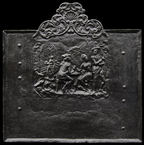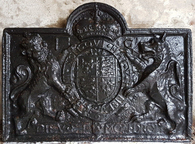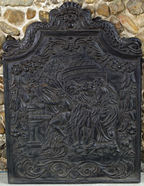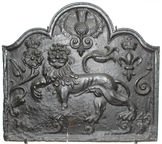-
711
Description: Rectangular plate with plain ovolo-moulded edging, superimposed by a fireback with, on top, arched mirrored scrolls surrounding a scallop shell, and below, a conversational scene of a man and woman seated at a small table with a soldier standing to the right and a building and servant behind to the right.
Notes: A composite fireback presumably intended to extend the width of an existing small one; rivets repair a crack.
- Decoration tags:
- rectangular with ornate arch (shape)
- ovolo (edging)
- carved pattern panels
- composite
- pictorial
- humans
Manufactured: in the early- to mid-18th century in England.
Current location: not known.
- Attached to series:
- Late pictorial series (all)
- Composite firebacks
- Late pictorial series 4
-
977
Description: Arched rectangular shape; ovolo moulded edging; Tudor royal shield, garter, crown, motto and supporters (crowned lion and dragon), temp. Elizabeth I; initials in space on either side of top of garter; the top of the lion's crown and the dragon's ear overlap the edging.
Notes: The initials have been added to an early recasting; another version has a rose and portcullis either side of the crown, and the top of the lion's crown and the dragon's ear do not overlap the edging.
Copies of this fireback are known.
Inscription: I G / [Garter] HONI SOIT QVI MAL E PENSE / [motto] DIEV ET MON DROIT
Arms: Tudor royal
- Decoration tags:
- rectangular with round arch (shape)
- ovolo (edging)
- whole carved pattern
- individual letters
- planklines
- armorial
- royal
- text
Manufactured: in the mid- to late-16th century possibly in the Weald area of England.
Current location: not known.
- Attached to series:
- Tudor royal armorial firebacks
- Tudor royal armorial (plain) series
-
716
Description: Cavetto canted rectangular central panel with ovolo-moulded edging, enclosing a pictorial scene of a naked female seated at a fountain on the left, with two clothed males to her right; behind, a part of a domed brick building with the inscription around the top of the wall; enclosing the scene, twin floral festoons suspended from top centre; on top, a central crown between two descending dolphins.
Notes: The scene depicts the Apocryphal story of Susanna and the Elders.
Copies of this fireback are known.
Inscription: SVSANA
- Decoration tags:
- 'Dutch' (shape)
- ovolo (edging)
- whole carved pattern
- pictorial
- biblical
- architectural
- humans
Manufactured: in the late-17th to early-18th century in Germany.
Current location: not known.
-
1157
Description: Arched rectangular shape; ovolo-moulded edging; a shield with the arms of the Grocers' Company on a cartouche, surrounded by four sprays of olive leaves.
Notes: The blazon of the arms is: Argent, a chevron gules between nine cloves six in chief and three in base proper. The arms were granted in 1532. The style of the fireback owes something to the design of French firebacks of the mid-17th century.
Copies of this fireback are known.
Arms: Worshipful Company of Grocers
- Decoration tags:
- rectangular with round arch (shape)
- ovolo (edging)
- whole carved pattern
- heraldic
- armorial
- plants
Manufactured: in the mid-17th century in England.
Current location: not known.
- Attached to series:
- Livery company firebacks
-
901
Description: Quasi-Arched rectangular shape with cyma reversa shoulders; ovolo edging; stylised lion passant guardant; crowned rose with leaf and stem on left, crowned fleur de lys on right, thistle with leaves above centre; three right-facing scrolls at base; down-facing scroll, with staple, on right side; date split between bottom corners; initials below date, bottom right.
Notes: Blatantly Royalist in its symbolism, a variant (no. 763) is dated (perhaps less convincingly) 1649. Numeral style, initials, leaf depiction and the stapled scroll are typical features of firebacks made from patterns by the same maker. A later version of the same subject, but with a different shaped plate and without the fleur-de-lys, is also known (see 'Royalist series'). M. A. Lower writes of this design of fireback being cast at Waldron Furnace in Sussex (Lower, 1849, p.219).
Copies of this fireback are known.
Inscription: 16 41 / IM
- Decoration tags:
- rectangular with round arch (shape)
- ovolo (edging)
- whole carved pattern
- heraldic
- royal
- text
- animals
Manufactured: in 1641 possibly at Brede Furnace in the Weald area of England.
Current location: in private hands, Wandsworth, London, England.
- Attached to series:
- IM series
- Hooked '1' series
- Stapled scroll series
- Brede group
-
737
Description: Armorial within complex ovolo moulded edging on all sides; two plank lines; the achievement is distinguished by the elaborately festooned mantling, the whole resting on a boat-shaped compartment.
Notes: The arms are of an esquire, and the crest - on a chapeau a wyvern, wings elevated and tail nowed, ducally gorged - matches that of the Trevor family. The shield is probably of impaled arms, i.e. those of a husband on the left and wife on the right. The husband's arms include several quarters with lions rampant, which were often a feature of the arms of Welsh families (of which the Trevors were one). The first quarter of the wife's arms is also of a wyvern, but the arms as a whole have not be identified. They have been variously, but incorrectly, attributed to John Trevor who married Elizabeth Morley, née Clarke, to Lord Dacre (a descendant of John Trevor), and to Col. Marcus Trevor, 1st Viscount Dungannon (peers' arms have supporters). The distinctive shape is seen in similar form on several other armorial firebacks from the mid-16th to 17th centuries, suggesting a continuity of pattern making, if not the same pattern maker. Many copies of this fireback exist.
Copies of this fireback are known.
Arms: Trevor
- Decoration tags:
- complex quasi-arched (shape)
- ovolo (edging)
- whole carved pattern
- planklines
- armorial
Manufactured: in the mid- to late-17th century in the Weald area of England.
Current location: Victoria & Albert Museum, Cromwell Road, Kensington & Chelsea, Greater London, England.
Museum number: 142.1892 (part of the Victoria & Albert Museum museum group)
Citation: Gardner, J. S., 1898, 'Iron Casting in the Weald', Archaeologia, 56, 1, pp. 133-164.
- Attached to series:
- Ornate border series
- Personal armorial firebacks
- Welsh armorial firebacks
-
743
Description: Arched rectangular shape; ovolo moulded edging; Tudor royal shield, garter, crown, motto and supporters (crowned lion and dragon), temp. Elizabeth I; the top of the lion's crown and the dragon's ear overlap the edging.
Notes: Another version has a rose and portcullis either side of the crown, and the top of the lion's crown and the dragon's ear do not overlap the edging; a faint blank rectangular stamp on each side of the crown may have been to hide initials, which have been noted on a variant of this fireback.
Copies of this fireback are known.
Inscription: [Garter] HONI SOIT QVI MAL E PENSE / [motto] DIEV ET MON DROIT
Arms: Tudor royal
- Decoration tags:
- rectangular with round arch (shape)
- ovolo (edging)
- whole carved pattern
- planklines
- armorial
- royal
- text
Manufactured: in the mid- to late-16th century possibly in the Weald area of England.
Current location: Victoria & Albert Museum, Cromwell Road, Kensington & Chelsea, Greater London, England.
Museum number: 794.1896 (part of the Victoria & Albert Museum museum group)
- Attached to series:
- Tudor royal armorial firebacks
- Tudor royal armorial (plain) series
-
763
Description: Quasi-Arched rectangular shape with cyma reversa shoulders; ovolo edging; stylised lion passant guardant; crowned rose with leaf and stem on left, crowned fleur de lys on right, thistle with leaves above centre; three right-facing scrolls at base; down-facing scroll, with staple, on right side; date split between bottom corners; initials below date, bottom right.
Notes: Blatantly Royalist in its symbolism, a variant (no. 901) is dated (perhaps more convincingly) 1641. Numeral style, initials, leaf depiction and the stapled scroll are typical features of firebacks made from patterns by the same maker. A later version of the same subject, but with a different shaped plate and without the fleur-de-lys, is also known (see 'Royalist series'). M. A. Lower writes of firebacks of this design of being cast at Waldron Furnace in Sussex (Lower, 1849, p.219).
Copies of this fireback are known.
Inscription: 16 49 / IM
- Decoration tags:
- rectangular with round arch (shape)
- ovolo (edging)
- whole carved pattern
- heraldic
- royal
- text
- animals
Manufactured: in 1649 possibly at Brede Furnace in the Weald area of England.
Current location: Victoria & Albert Museum, Cromwell Road, Kensington & Chelsea, Greater London, England.
Museum number: 492.1901 (part of the Victoria & Albert Museum museum group)
Citation: Lloyd, N., 1925, 'Domestic Ironwork I', Architectural Review, 58, pp. 58-67.
- Attached to series:
- IM series
- Hooked '1' series
- Stapled scroll series
- Brede group
-
766
Description: Canted rectangle; ovolo-moulded edging; shield and dolphin crown of the dauphin of France, encircled by the Ordre d'Esprit and the Ordre de St Michel; dolphins in the bottom corners, separating digits of the date.
Notes: The 24th Dauphin was Louis, son of Louis XV and father of Louis XVI. Part of the bequest to the Victoria and Albert Museum by Lieut. Colonel G. B. Croft-Lyons in 1926.
Inscription: 1 7 5 0
Arms: Dauphin of France (24th Dauphin)
- Decoration tags:
- rectangular with canted top corners (shape)
- ovolo (edging)
- whole carved pattern
- armorial
- royal
Manufactured: in 1750 in France.
Current location: Victoria & Albert Museum, Cromwell Road, Kensington & Chelsea, Greater London, England.
Museum number: M.625-1926 (part of the Victoria & Albert Museum museum group)
- Attached to series:
- Foreign armorial firebacks
-
775
Description: Arched rectangle; ovol-moulded edging; pictorial scene of a begowned figure waving to figures standing beneath a portico with a sun behind, other figures opening a door to his left, above which is the shape of the man in the moon; blottom left, a computer; bottom right, a painter's palette.
Notes: A farewell gift to William Vaughan, Reader in Art History at University College, London (later professor of the History of Art at Birkbeck College).
Inscription: WILLIAM VAUGHAN / 1972 UNIVERSITY 1986 / COLLEGE
- Decoration tags:
- rectangular with round arch (shape)
- ovolo (edging)
- whole carved pattern
- pictorial
- architectural
- text
- humans
Manufactured: in 1987 in England.
Current location: Victoria & Albert Museum, Cromwell Road, Kensington & Chelsea, Greater London, England.
Museum number: M.15-1994 (part of the Victoria & Albert Museum museum group)
- Attached to series:
- Personal firebacks









